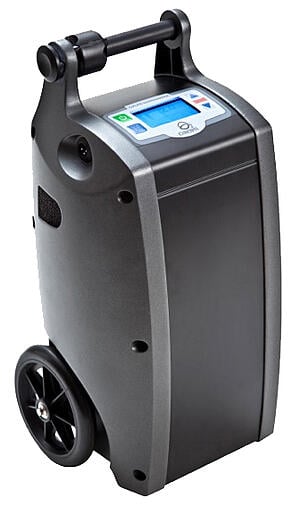
With the advent of the portable oxygen concentrator, oxygen users were given the freedom to travel and enjoy more independent lives. Some concentrators are as small as 2 pounds and can be carried on a belt loop or in an over-the-shoulder bag.
After being chained to a heavy, cumbersome tank, concentrators such as the Inogen One G4 feel light as a feather. Some concentrators, such as the Inogen One G3 or Activox 4L are slightly larger but still weigh in the 5 pound range, even with extended life batteries attached. These sleek units are inconspicuous and easy to carry either with a shoulder strap or in available backpacks. These concentrators are perfect for those on a pulse flow up to 4.
Sometimes when patients who are on a continuous flow see the size of the portables they are disappointed that their prescription prevents them from using one of the smaller machines. Yes, these machines are slightly larger than their pulse flow counterparts, but you’d be surprised how light and easy the machines are to maneuver. People think that added size and weight means less portability and mobility but nothing could be further from the truth!
The larger machines, like the Oxlife Independence, are even easier to tote around in a lot of ways.
A person will expend a lot more energy carrying 5 pounds than they will pushing 20. For instance, a person weighing 150 pounds, carrying 5 pounds, will expend 181 calories walking for 30 minutes at a moderate pace. That same person will expend 120 calories waling for 30 minutes while pushing or pulling 20 pounds.
A device that can roll on a cart or in a bag is also more hands free. If you are walking around in a store or stop for a moment to rest, your medical device can sit securely next to you without having to look for a safe, dry place to put it down. It can also sit on the floor next to you while at a restaurant, church, theater, or sporting event.
Despite the increased size of some of the continuous units, all of the concentrators that we sell are FAA approved and easily pass through security at the airport. They also fit underneath airplane seats and fall under ADA rules for in flight use. As concentrators become more commonplace, passing through TSA and getting them on to airplanes becomes easier all the time. Please see our travel information for tips on traveling with oxygen and be sure to call your airline for their specific requirements on traveling with oxygen.
Don’t let the visible size difference get you down! Your continuous flow unit offers the same freedom and independence as any of the smaller hand-held units and you’ll have more versatility in terms of using it with CPAP or BiPAP when traveling or changing your oxygen flow for changing conditions.
Learn more about portable oxygen concentrators, see if a portable concentrator is right for you, and more by downloading our Official Guide to Portable Oxygen Concentrators!

